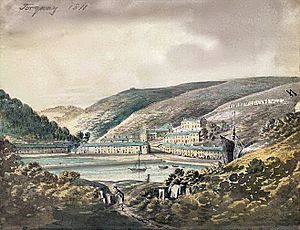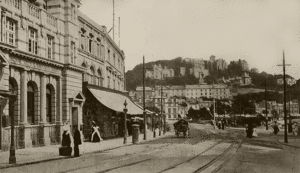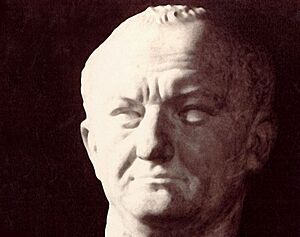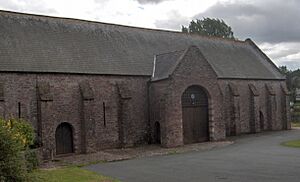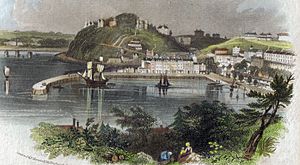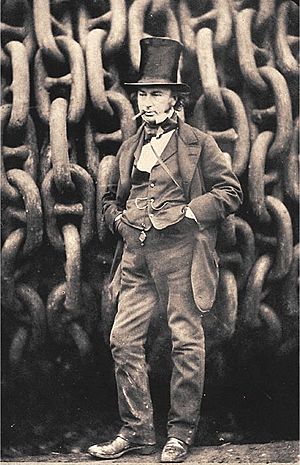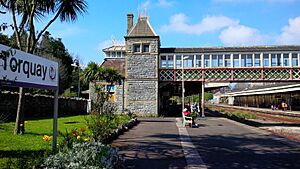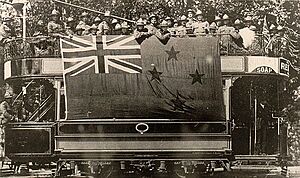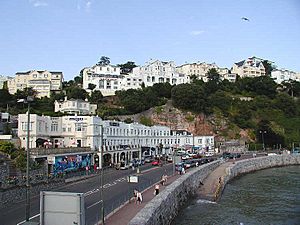History of Torquay facts for kids
The History of Torquay tells the story of a town in Torbay, on England's south coast. Its history goes back about 450,000 years! That's when early humans left tools in Kents Cavern. For a long time, there wasn't much sign of people living here permanently. But we know Roman soldiers visited, and there was a small Saxon village called 'Torre'.
A big change happened in 1196 when Torre Abbey was built. This abbey became the richest of its kind in England before it closed down in 1539. Later, rich families like the Carys, Palks, and Mallocks owned most of the land that is now Torquay.
The town really started to grow in the early 1800s. Lawrence Palk, a local landowner, built a new harbour. People who were feeling unwell started visiting Torquay in winter because of its fresh air and mild weather. The town's population grew very quickly! Later in the century, Torquay became a popular place for wealthy people to visit. In 1870, another new harbour was built, making it great for yachting. It was also used to bring in coal and wool from Australia.
During World War I, many hospitals were set up in Torquay. Between the wars, a big advertising campaign made Torquay a major holiday spot. In World War II, the town's many hotels were used to train RAF aircrew. American troops were also stationed here from 1944. Sadly, the town was bombed several times.
After the wars, Torquay hosted the watersports for the 1948 Summer Olympic Games in 1948. In 1950, the European Broadcasting Union (which runs the Eurovision Song Contest) was formed here. More recently, Torquay has become popular with students learning English. Since 2004, many workers from countries like Poland and the Czech Republic have moved to the town.
Contents
- Ancient Times and Roman Visitors
- Medieval and Renaissance Torquay
- Napoleonic Wars and Early Growth
- Torquay Becomes a Holiday Resort (1821–1848)
- Railway Arrival and Challenges (Mid-19th Century)
- Torquay's Golden Age (Late 19th Century)
- Early 20th Century Changes
- Torquay During World War I
- Between the World Wars
- Torquay During World War II
- Torquay Since 1945
- Members of Parliament
- Images for kids
Ancient Times and Roman Visitors
The area where Torquay is today has been lived in for a very long time. Stone tools found in Kents Cavern are 450,000 years old! There's even a small bone from Kents Cavern that might be the oldest sign of a modern human in Europe.
We don't know much about Torquay's early days until the Roman Empire arrived in Britain in 43 AD. Roman soldiers visited Torquay, leaving gifts at a strange rock in Kents Cavern called 'The Face'. These soldiers might have been part of the Legio II Augusta, led by the future Emperor Vespasian. He was very active in the South West of England.
No Roman towns have been found in Torquay itself. But Roman items have been found nearby in Totnes and Newton Abbot. On Berry Head, across Torbay, an old fort and Roman coins were found. In 1840, during building work on Torquay seafront, workers found a very old, wide road. Some historians think this might have been a Roman road.
After the Romans left Britain around 410 AD, a British kingdom called Dumnonia formed in the West Country. Torquay would have been part of this kingdom. Later, the Anglo-Saxon kingdom of Wessex gradually took over Dumnonia. There's no sign that Vikings visited Torquay during this time.
Medieval and Renaissance Torquay
Much of modern Torquay sits on an old estate called Tor Mohun. This land belonged to William Brewer in the 1200s. The Domesday Book mentions different parts of Torquay, like Cockington and St Marychurch.
In 1196, Torre Abbey was founded by William Brewer. The abbey owned a lot of land and became very rich. It was partly built with stone from nearby Corbyn Head. But in 1539, King Henry VIII closed down all monasteries, including Torre Abbey. The monks from Torre Abbey also founded the nearby town of Newton Abbot.
Torquay itself grew around a Saxon village called Torre. The name 'Torquay' comes from 'tor' (meaning hill) and 'quay' (a place for boats). The monks of Torre Abbey are thought to have built the first fishing quay.
The Cary family bought Torre Abbey in 1662. They were important in Torquay's growth and owned much of the area, including Cockington. Another family, the Mallocks, later bought Cockington. The Mohun family also owned land in the area, which is why it was called Tor Mohun.
In 1521, a member of the Cary family married Mary Boleyn, who was the sister of King Henry VIII's second wife, Anne Boleyn. This made him the uncle of the future Queen Elizabeth I.
After the failed Spanish Armada in 1588, a medieval barn at Torre Abbey was used to hold 397 Spanish prisoners. Because of this, it became known as the "Spanish Barn."
In 1688, William III landed nearby in Brixham during the 'Glorious Revolution'. He passed through Torquay on his way to London to take control of the country.
Napoleonic Wars and Early Growth
In 1794, an early visitor described Torquay as a "pretty range of neat new buildings, fitted up for summer visitors." Another said it was "not England, but a bit of sunny Italy."
Torquay's growth was helped by the Napoleonic Wars. Rich people couldn't travel to Europe, so they looked for places to visit in England. Torbay was a great, sheltered place for ships. The Channel Fleet, which protected England from Napoleon, often used the bay. So, wives and families of officers visited Torquay to be near their loved ones.
The town's first major development was thanks to Sir Lawrence Palk, 2nd Baronet. He decided to build a new harbour. Work started in 1803 and finished in 1807. The harbour was designed by John Rennie the Elder, who also designed London Bridge.
Sir Lawrence Palk brought ideas for villa designs from Italy. These were built by William Kitson, who was known as "the Maker of Torquay." Kitson created an exclusive area with beautiful houses like Hesketh Crescent, which was called the "finest crescent of houses in the West of England."
After the Battle of Waterloo, Napoleon was held on a warship, HMS Bellerophon, in Torbay for two days. He reportedly said, "What a lovely country!" Admiral Nelson also visited Torquay in 1801.
Torquay Becomes a Holiday Resort (1821–1848)
In 1821, fewer than 2,000 people lived in Torquay, but this was about to change dramatically. In 1832, Torquay got its first bank, run by William Kitson. Kitson played a huge role in shaping Torquay. He was in charge of the Palk family's estates and was elected as a local government commissioner in 1835. He brought important services to the town, like roads, a sewer system, water supply, and street lighting.
In 1833, Princess Victoria visited Torquay for the first time. Today, Victoria Parade is named after her visit. Around this time, Torquay became known as a health resort. Its mild winter climate and fresh air attracted many wealthy visitors who were unwell. This new image lasted for the rest of the century. The town's population grew from 838 in 1801 to 11,474 in 1851!
During this period, three main families owned most of the town: the Mallocks, the Carys, and the Palks. The Mallocks, who owned Cockington, didn't want a town on their land and tried to stop development for a long time.
Railway Arrival and Challenges (Mid-19th Century)
In the 1840s, railways became very important in England. People in Torquay knew that a railway would bring more visitors and wealth. Finally, on 18 December 1848, Torre railway station opened. This connected Torquay to the rest of the country for the first time. By 1850, the town was calling itself "The Queen of Watering Places." Between 1841 and 1871, Torquay's population grew by over 5,000 people every ten years.
There was a big debate about extending the railway to the harbour. Some wanted it for industry, but others wanted Torquay to remain a tourist town. In the end, the railway was extended to the sea but not directly to the harbour. This helped Torquay keep its character as a tourist destination. The new railway station opened in 1859.
The famous engineer Isambard Kingdom Brunel was important in Torquay's railway history. He even bought land in the Watcombe area, planning to retire there, but he passed away early.
While wealthy people enjoyed beautiful homes, the working classes lived in crowded areas with poor conditions. Many faced hunger and health problems. In one year, 66 people died from a cholera outbreak in just six weeks.
Life was hard for many. Some people left Torquay for America and Canada. In 1846, the potato crop failed, and bread prices rose sharply. This caused great hardship. On 17 May 1847, a crowd gathered and attacked bakeries. The rioters then smashed windows in other shops. Authorities eventually brought in coastguards and soldiers to restore order.
Torquay's Golden Age (Late 19th Century)
As Torquay grew more popular with wealthy Europeans, it attracted famous visitors. The Russian Romanoff noble family built a holiday home, Villa Syracusa (now The Headland Hotel), where they entertained the Russian Royal Family.
In 1850, Prince Peter of Oldenburg, a cousin of the Russian Tsar, visited. He laid the foundation stone for the new Torbay Infirmary (now Torbay Hospital). The Imperial Hotel also hosted many famous guests, including Emperor Napoleon III of France and King Edward VII. Benjamin Disraeli, a future Prime Minister, was also a frequent visitor.
Although growth slowed in the 1870s and 1880s as the wealthy started travelling abroad, nearby areas like St. Marychurch and Cockington grew. In 1870, Lawrence Palk, 1st Baron Haldon built another new harbour, making Torquay popular for yachting. The town was also important for importing coal and wool. In 1886, a guide declared Torquay the "wealthiest town in England" for its size.

Many famous writers lived in or visited Torquay during this time. Charles Kingsley (author of The Water Babies) and Elizabeth Barrett Browning lived here. Rudyard Kipling lived in Maidencombe in 1896, and his house may have inspired his story The House Surgeon. It's also believed that Oscar Wilde's A Woman of No Importance and Sir Arthur Conan Doyle's The Hound of the Baskervilles were created while their authors were staying in Torquay. Even Charles Darwin finished parts of The Origin of Species while in the town.
Torquay's first sports ground, the Recreation Ground, opened in 1888. In 1889, the Winter Gardens were built for entertainment. This large glass and iron building could hold 1,000 people for concerts. However, it wasn't very successful and was sold to Great Yarmouth in 1903. The building was carefully moved by barge and is still in use there today.
The famous crime writer Agatha Christie was born in Torquay on 15 September 1890. Many of her novels are set in places similar to Torquay.
In 1892, Torquay got through trains and was granted borough status, meaning it could govern itself more. Its motto became Salus et Felicitas (Health and Happiness). The town was ready to grow and become a major holiday resort. In 1899, Torquay United Football Club was founded, becoming the town's first professional sports team.
Early 20th Century Changes
The early 1900s saw a big change for Torquay. In 1902, the town started advertising to attract healthy visitors and families, not just those seeking health cures. Torquay became a summer holiday resort, popular with families from industrial areas of England. This led to more train travel until World War I.
Torquay also grew in size. In 1900, Chelston and Livermead joined the town. In 1903, the nearby area of St Marychurch also became part of Torquay. Finally, in 1928, Cockington was included. With these additions, Torquay became much larger, covering areas like Livermead, Cockington, Chelston, St Marychurch, Plainmoor, Babbacombe, Watcombe, and Maidencombe.
The famous electrical engineer and mathematician Oliver Heaviside lived in Torquay from 1909 until his death in 1924. In 1905, over 100 warships of the Royal Navy anchored in the bay, and King George V reviewed the Home Fleet there before the war began in 1914.
Torquay During World War I
When World War I started in 1914, many young men from Torquay volunteered for military service. They marched through the town on their way to France and Belgium.
Torquay soon felt the war's effects. In August 1914, the Red Cross Hospital opened in the Town Hall. Wounded soldiers began arriving from France in October. Many other hospitals and convalescent homes were set up in the town's large houses. In November, Queen Mary visited the injured servicemen.
In December 1914, 1,100 men of the Royal Dublin Fusiliers arrived in Torquay. Before they left for the front lines, their commanding officer gave their regimental flags to the town for safekeeping. These soldiers were later sent to the ill-fated Gallipoli campaign.
In September 1915, King George V and Queen Mary visited the hospitals again to see wounded soldiers. There were so many casualties that Torbay Hospital set aside over 50 beds for them.
From May 1917, wounded soldiers from the New Zealand Expeditionary Force began arriving. They stayed in a special camp in St Marychurch. Their presence led to the opening of clubs for them, like the Kia Toa Club (now the Victorian Arcade).
In September 1918, the Spanish flu hit Torquay. Over 100 American servicemen died from the disease at Oldway Hospital. They were later moved back to the United States.
The war ended on 11 November 1918. Weeks later, a German submarine, U-161, arrived in Torquay harbour. On Boxing Day 1918, the town mayor returned the regimental flags to the Dublin Fusiliers. Out of the 1,100 men who had arrived in Torquay, only 40 were left after the terrible fighting at Gallipoli.
Between the World Wars
After World War I, a successful advertising campaign by the Great Western Railway Company made Torquay a major holiday resort. In 1924, Torquay hosted an international summer school, which was the last visit to Britain by the Austrian philosopher Rudolf Steiner. By August Bank Holiday in 1938, just before World War II, 20,000 passengers arrived at Torquay station in one day!
Torquay also saw some political changes. In 1926, Francis John Marnham, a former Member of Parliament, served as Mayor of Torquay. Later, Oswald Mosley's British Union of Fascists tried to gain support in the area. While they had many members in nearby Plymouth, the Torquay branch was much smaller, with only 34 members at its peak in 1933.
Torquay During World War II
Training for 'air-raid precautions' began in Torquay as early as 1935. By January 1939, wardens were recruited, and gas masks were fitted for 20,000 to 30,000 people. The Upton Primary School was bought to be the air-raid headquarters.
On 1 September 1939, two days before war was declared, permanent 'Wardens' Posts' were set up. The first air-raid exercise happened eight days later, simulating a German attack. Soon after, rationing for meat and petrol was announced.
In October, the Palace Hotel was taken over by the government. It became a hospital and training facility for RAF officers, known as RAF Hospital Torquay. Many aircrew recovered and trained there, including James Brindley Nicolson, the only Battle of Britain pilot to receive the Victoria Cross.
In 1940, machine-gun posts and pillboxes were built along Torquay's coastline to prepare for a possible invasion. Naval guns were placed on Corbyn Head, just as they had been against Napoleon's troops. The British Home Guard was also formed, with 600 men joining in Torquay.
Torquay's hotels were used by the RAF to train aircrew. No 1 Initial Training Wing (ITW) was formed in Babbacombe, training almost 27,000 airmen. No 3 ITW and No 5 ITW also came to Torquay, training thousands more.
In 1941, Torquay held its first "War Weapons Week" to raise money for the war effort. Evacuees from Bristol and Plymouth arrived in Torquay during the the Blitz air attacks on those cities. Iron railings were removed from homes to be melted down for munitions.
Torquay had its first serious air raid on 22 April 1941. Most early attacks were from German pilots dropping bombs left over from raids on Plymouth. No 13 ITW was formed in Torquay in June 1941 to train pilots and navigators from Commonwealth and Allied Air Forces. This wing also recorded the first arrival of American troops in Torbay.
In March 1942, a small ship meant to block Torquay Harbour was sunk in an air-raid. On 7 June, Torquay was attacked by four aircraft. Another major raid on 25 October severely damaged RAF Hospital, Torquay, causing 43 casualties and 19 deaths.
One of the worst tragedies happened in 1943 during the "Rogation Sunday" attack. The Parish Church at St. Marychurch was destroyed, and 21 children died. One German aircraft accidentally hit the spire of a nearby church and crashed into houses.
In early 1944, thousands of US Army personnel arrived in Torquay to prepare for the D-Day landings. They were housed in private homes and hotels. Torquay played a vital role in the landings, with over 23,000 men of the American 4th Infantry Division departing from Torquay for Utah Beach.
The last recorded air raid on Torquay during the war was on 29 May 1944. Soon after, the visiting restrictions were lifted, and American and Commonwealth troops left for Normandy. Torquay was declared 'open to visitors' in May 1945, having made a huge contribution to the war effort.
Torquay Since 1945
After the war, holiday patterns changed. More people could afford to travel abroad, and car ownership became common. This meant fewer visitors to British resorts, and many who came stayed in smaller bed-and-breakfasts instead of large hotels.
In 1948, Torbay hosted the watersports events for the 1948 Summer Olympic Games. The Olympic flame burned at Torre Abbey Gardens during the games.
In 1950, the European Broadcasting Union (EBU) was formed in Torquay. This group of broadcasting organizations from Europe is most famous for organizing the Eurovision Song Contest.
In the early 2000s, Torquay became more known abroad and attracted more foreign tourists. It's also a popular place for students from other countries to come and learn English.
In October 2005, Torquay chose its first directly elected mayor, Nicholas Bye. Since the expansion of the EU in 2004, many workers from Eastern Europe, especially Poland and the Czech Republic, have settled in Torquay. This has led to local changes, like the newspaper The Herald Express publishing a weekly Polish column and a Polish shop opening in town.
On 28 May 2022, a large yacht caught fire in Torquay Harbour. The police and coastguards evacuated the area. Firefighters secured the boat, but it sank. Luckily, no one was hurt.
Members of Parliament
- Lord John Russell (Whig) 1832–1835
- John Crocker Bulteel (Whig) 1832–1835
- Sir John Yarde Buller (Conservative) 1835–1858
- Montagu Edmund Parker (Conservative) 1835–1849
- Sir Ralph Lopes (Conservative) 1849–1854
- Sir Lawrence Palk (Conservative) 1854–1868
- Samuel Trehawke Kekewich (Conservative) 1858–1868
- Sir Edward Courtenay (Conservative) 1868–1870
- Sir Lawrence Palk (Conservative) 1854–1880
- Sir John Henry Kennaway (Conservative) 1870–1885
- Lt. Col William Hood Walrond (Conservative) 1880–1885
- Lewis McIver (Liberal) 1885–1886
- Richard Mallock (Conservative) 1886–1895
- Commander Arthur Phillpotts (Conservative) 1885–1900
- Sir Francis Layland-Barratt (Liberal) 1900–1910
- Colonel Charles Rosdew Burn (Unionist) 1910–1923
- Captain Piers Gilchrist Thompson (Liberal) 1923–1924
- Charles Williams (Conservative) 1924–1955
- Frederic Bennett (Conservative) 1955–1974
- Sir Frederic Bennett (Conservative) 1974–1987
- Rupert Allason (Conservative) 1987–1997
- Adrian Sanders (Liberal Democrats) 1997– 2015
- Kevin Foster (Conservative) 2015 -
Images for kids


